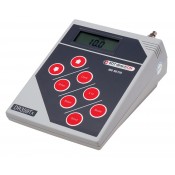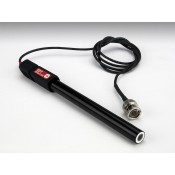Bromide in Water
A method for the measurement of Bromide in ground, drinking and waste waters from 0.5 ppm to1000
This range may be extended by dilution or the use of an incremental technique.
Equipment Required
2. 3271 Bromide Combination ISE
3. 21302 Bromide 1000ppm Standard Solution
4. 30302 Bromide Ionic Strength Adjustment Buffer
5. Glassware. Beakers 250ml, Volumetric Flask 100ml. 10ml Graduated pipette
6. Deionised water.
7. Nickel Sulphate solution. 1Molar
Preparation of Nickel Sulphate Solution
Dissolve 26.3g of NiSO4.6H2O in distilled water. Dilute to 100 ml. This solution is only required if there is Sulphide or Cyanide present in the samples
Sample Preparation
To any sample containing sulphide or cyanide, add 0.1 ml nickel sulphate solution per 100 mls of sample. This will react with 58 ppm sulphide or 117 ppm cyanide.
Standard Preparation
Prepare standards of 100, 10ppm by serial dilution of the 21302 1000 ppm Standard solution. This is best achieved by pipetting 10ml of the 1000ppm standard into a 100ml volumetric flask and diluting to the mark with deionized water. This is now a 100ppm Standard solution. Prepare further standards as necessary.
Method
To 100ml of each of the standards and samples add 2ml of 30302 ISAB and mix the contents. Be sure the beakers are clean and make sure not to touch the inside of the beakers with bare hands as contamination from sweat etc. is common. Beakers that have been washed with softened water or tap water will be contaminated. In these cases rinse the beakers with deionised water.
Immerse the 3271 Bromide ISE in each of the standards in increasing concentration steps following the calibration routine on the Ion Meter, rinsing the electrodes with distilled water and dabbing off the excess water between standards.
Using the DR359TX Ion meter will allow the result to be read directly on the display. It also allows for up to a 5 point calibration if required.
If you do not have an ION meter you can read the mV values using a pH/mV meter such as an EDT model FE257. Record the mV response and plot a graph of mV vs. log of Concentration.
Interferences:
Sulphide and cyanide ion interference is removed by the addition of the NiSO4.6H2O solution.
Concentrations of free metal ions causing a 10% error are:
Bi+++80 ppm, Cd++100 ppm, Pb++ 1600 ppm, Sn++2400 ppm, Tl+++4 ppm
Chloride and hydroxide do not interfere when present in concentrations in excess of bromide by up to 4 x 102 and 3 x 104 respectively.
There will be no interference from ammonia when present in concentrations twice that of bromide, nor from thiosulphate 20 times as concentrated as bromide. Iodide is an interference at a concentration ratio of 2x10-4 Mercury should be absent from the sample.


